
Ammonoids are a group of extinct marine mollusc animals in the subclass Ammonoidea of the class Cephalopoda. These molluscs, commonly referred to as ammonites, are more closely related to living coleoids than they are to shelled nautiloids such as the living Nautilus species. The earliest ammonites appeared during the Devonian, with the last species vanishing during the Cretaceous–Paleogene extinction event.

The Nautilida constitute a large and diverse order of generally coiled nautiloid cephalopods that began in the mid Paleozoic and continues to the present with a single family, the Nautilidae which includes two genera, Nautilus and Allonautilus, with six species. All told, between 22 and 34 families and 165 to 184 genera have been recognised, making this the largest order of the subclass Nautiloidea.

Goniatites is a genus of extinct cephalopods belonging to the family Goniatitidae, included in the superfamily Goniatitaceae. Hibernicoceras and Hypergoniatites are among related genera.

Nautiloids are a group of marine cephalopods (Mollusca) which originated in the Late Cambrian and are represented today by the living Nautilus and Allonautilus. Fossil nautiloids are diverse and speciose, with over 2,500 recorded species. They flourished during the early Paleozoic era, when they constituted the main predatory animals. Early in their evolution, nautiloids developed an extraordinary diversity of shell shapes, including coiled morphologies and giant straight-shelled forms (orthocones). Only a handful of rare coiled species, the nautiluses, survive to the present day.
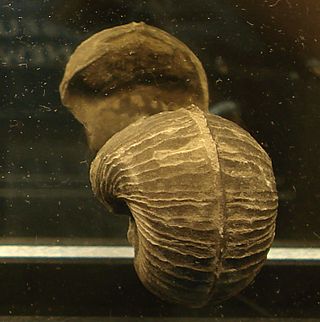
Bellerophon is a genus of extinct paleozoic marine molluscs of uncertain position in the family Bellerophontidae.

The Serpulidae are a family of sessile, tube-building annelid worms in the class Polychaeta. The members of this family differ from other sabellid tube worms in that they have a specialized operculum that blocks the entrance of their tubes when they withdraw into the tubes. In addition, serpulids secrete tubes of calcium carbonate. Serpulids are the most important biomineralizers among annelids. About 300 species in the family Serpulidae are known, all but one of which live in saline waters. The earliest serpulids are known from the Permian.
Agathiceras is a subglobose goniatitid from the family Agathiceratidae, widespread and locally abundant in Lower Pennsylvanian to Middle Permian sediments, e.g. the Urals, Sicily, and Texas.

Ceratitida is an order that contains almost all ammonoid cephalopod genera from the Triassic as well as ancestral forms from the Upper Permian, the exception being the phylloceratids which gave rise to the great diversity of post-Triassic ammonites.
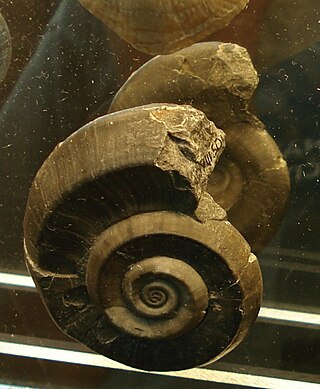
Euomphalus is a genus of fossil marine gastropods known to have lived from the Silurian to the Middle Permian.
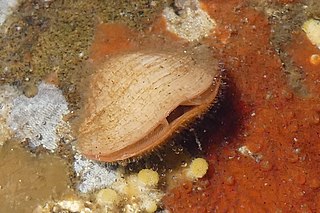
Brachiopods, phylum Brachiopoda, are a phylum of trochozoan animals that have hard "valves" (shells) on the upper and lower surfaces, unlike the left and right arrangement in bivalve molluscs. Brachiopod valves are hinged at the rear end, while the front can be opened for feeding or closed for protection. Two major categories are traditionally recognized, articulate and inarticulate brachiopods. The word "articulate" is used to describe the tooth-and-groove structures of the valve-hinge which is present in the articulate group, and absent from the inarticulate group. This is the leading diagnostic skeletal feature, by which the two main groups can be readily distinguished as fossils. Articulate brachiopods have toothed hinges and simple, vertically-oriented opening and closing muscles. Conversely, inarticulate brachiopods have weak, untoothed hinges and a more complex system of vertical and oblique (diagonal) muscles used to keep the two valves aligned. In many brachiopods, a stalk-like pedicle projects from an opening near the hinge of one of the valves, known as the pedicle or ventral valve. The pedicle, when present, keeps the animal anchored to the seabed but clear of sediment which would obstruct the opening.

Claraia is an extinct genus of scallop-like bivalve molluscs that lived from the Capitanian stage of the Late Permian to the Anisian stage of the Middle Triassic, 266-237 million years ago. Fossils have been found worldwide in North America, Europe, Asia, Africa, and Australia. These are common fossils subsequent to the Permian-Triassic boundary, suggesting that the genus experienced rapid diversification during and after the Permian–Triassic extinction event, around 251.4 million years ago.
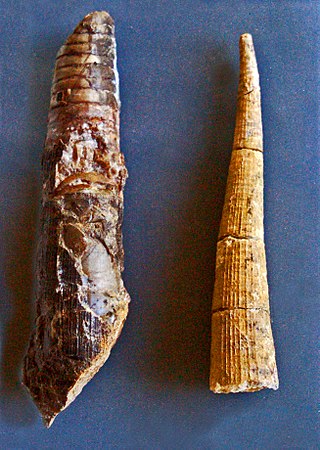
Kionoceras is an extinct nautiloid cephalopod genus included in the orthocerid family Kionoceratidae with scattered worldwide distribution from the Middle Ordovician to the Lower Permian. Kionoceratids are orthocerids with prominent longitudinal ornamentation on their shells, sometimes augmented by secondary transverse ornamentation. Orthocerids are, of course, prehistoric nautiloides with generally straight and elongate shells, mostly with central or subcentral siphuncles.
Stearoceras is an extinct genus of prehistoric nautiloids from the Lower Pennsylvanian - Lower Permian with a fair worldwide distribution.(Kümmel 1964)
Bitaunioceras is a genus of Permian orthocerids with a gradually expanding, straight, orthodontic shell with straight transverse sutures and a small, subcentral siphuncle with straight tubular orthochromatic necks.
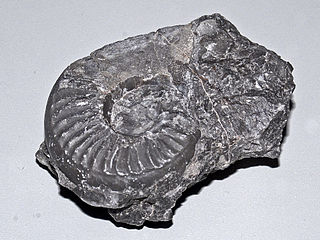
Tainoceratidae is a family of late Paleozoic and Triassic nautiloids that are a part of the order Nautilida, characterized by large, generally evolute shells with quadrate to rectangular whorl sections. Shells may bear ribs or nodes, or both.

Pleuronautilus is a nautiloid genus; family Tainoceratidae, order Nautilida.
Cibolites is a genus of ammonoid in the family Paraceltitidae of the cephalopod order Ceratitida which lived during the Late Permian. The genus was first found the Texas and Mexico. The shell is similar to that of Xenodiscites but smooth and with goniatitic sutures.

Paraceltites is a genus of ammonoid cephalopods in the ceratitid family Paraceltitidae, known from the Middle and Upper Permian of Sicily, the Alps, Crimea, Texas and Mexico. The shell of Paraceltities is evolute with whorls compressed, venter arched and smooth, sides bearing ribs that slant somewhat forward dorso-ventrally. The suture is simple and goniatitic.

Metalegoceras is an extinct genus of marine cephalopods belonging to the family Schistoceratidae.

Opisthodontosaurus is an extinct genus of captorhinid reptile from the Early Permian of Oklahoma. The type species Opisthodontosaurus carrolli was named in 2015 on the basis of several articulated skeletons from the Dolese Brothers Limestone Quarry near Richards Spur. Before the description of these skeletons, the jaws and teeth of Opisthodontosaurus carrolli were thought to belong to a species of lepospondyl amphibian called Euryodus primus. Although captorhinid reptiles and lepospondyl amphibians are distantly related, the two species show a remarkable degree of evolutionary convergence in their dental anatomy. Both were likely durophagous, eating hard-shelled invertebrates.















